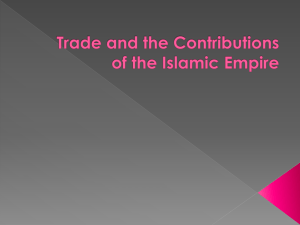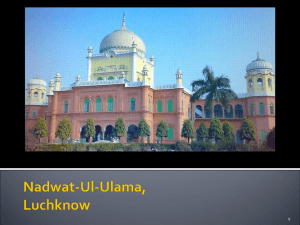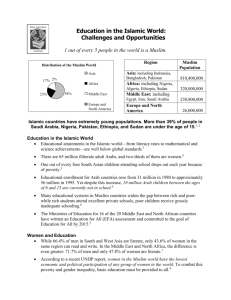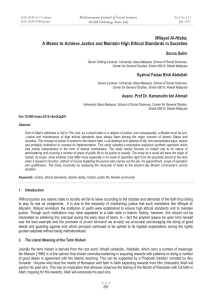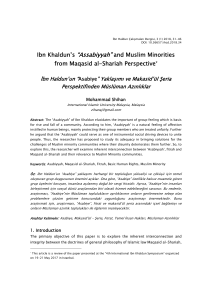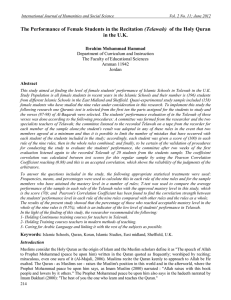Sultans of Science Islamic Golden Age
advertisement
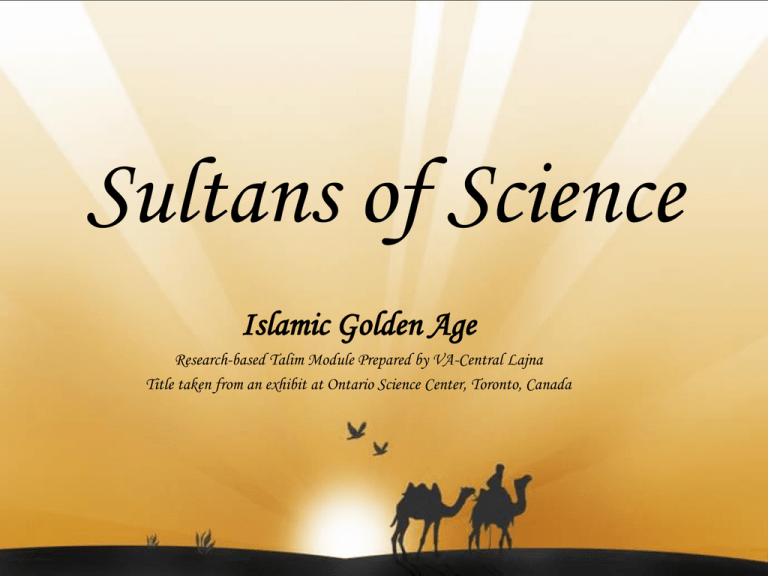
Sultans of Science Islamic Golden Age Research-based Talim Module Prepared by VA-Central Lajna Title taken from an exhibit at Ontario Science Center, Toronto, Canada The Holy Quran, Surah Al-Baqarah, verse 165: “Verily, in the creation of the heavens and the earth and in the alternation of night and day, and in the ships which sail in the sea with that which profits men, and in the water which Allah sends down from the sky and quickens therewith the earth after its death and scatters therein all kinds of beasts, and in the change of the winds and the clouds pressed into service between the heaven and the earth—are indeed Signs for the people who use their understanding.” Foundations of Islamic Golden Age • Time period is about 7th century to 13th century in the Muslim world. • The Holy Quran is the Divine Light, sent to illuminate the entire world. • Holy Prophet (saw) said that acquisition of knowledge is an obligation upon every Muslim man & woman. • Muslim world emphasizes education, experimenting, innovation, & reasoning. Islamic Empire gathers knowledge from various civilizations such as North African, Egyptian, Greek, Roman, Byzantine, Mesopotamian, Persian, Indian, & Chinese. Baghdad, Cairo, & Cordoba were intellectual centers. Expansion under Hadhrat Muhammad (saws), 622-632 Expansion during the Rashidun Caliphate, 632-661 Expansion during the Umayyad Caliphate, 661-750 Paper helps knowledge spread. • Muslims learned & improved the technique of papermaking from the Chinese after Battle of Talas in 751. • Paper mills were built in Muslim cities like Baghdad. • With paper comes books—and the writing & sharing of knowledge through public and lending libraries and learning institutions. • Scholars gathered and translated the world’s knowledge, including classical works, into Arabic. Later it would be translated to other languages such as Latin, Persian, Turkish, and Hebrew. • Paper-making would spread to Europe much later in the 13th to early 15th centuries, according to various sources. Educational & Scientific Institutions • Concept of degree-granting university originated in Muslim world. World’s oldest universities are University of Al-Karaouine in Fez, Morocco in 859 and Al-Azhar University in Cairo, Egypt in 975. • Medical diplomas issued to practicing doctors. • Bimaristan hospitals (provided care for ill by qualified doctors—similar to modern hospitals) were separate from mental institutions and quarantine hospitals. • Astronomical research observatories were founded, which opposed the concept of astrology & fortunetelling. Muslim Polymath Scholars • A scholar who contributed to a variety of fields of knowledge (for example, a person who is excels in science, math, poetry, art, and philosophy, ethics, and engineering), instead of specializing in a single field. • Also known as “hakeems,” they were prevalent in the Islamic Golden Age. • Similar to “Renaissance Men” developing later in Europe. Advancements in Medicine Contributions of Famous Physicians Al Razi (Rhazes) • • • • • • • • • • 864- 930 AD Born in Iran Studied small pox and chicken pox Found treatment for kidney and gall stones First to introduce alcohol for medical purposes First to use opium for anesthesia Stressed psychological factors like having a positive attitude Was appointed physician in chief of the Baghdad hospital This was the first hospital to have a separate ward for the mentally ill Was the first to realize the reaction of the pupil to light Ibn Sina • • • • • • 980-1037 AD Author of Al- Qanun al- Tibb (Encyclopedia of Medicine) This textbook was used for medical education from the 12th-17th century Figured out how many extrinsic muscles there were on the eyeball (six) Known as Avicenna in the West Discovered contagious nature of some illness (due to bacteria & virus) and modes of transmission Al- Zahravi • 963-1013 AD • “Father of Surgery” • Wrote medical encyclopedia which included designs of 200 surgical instruments • Performed operations such as caesarians • Was the first to use silk thread to stitch up wounds • Was also an oral surgeon • Came up with the procedure of setting false teeth made from animal bones Picture of some of the Surgical Instruments Ibn Zuhr • • • • 1091-1161 CE First to test medicines on animals, and then give to humans First to figure out diseases caused by parasites First to use tracheotomy, feeding through a tube when normal feeding isn’t possible Al Biruni • 973-1048 AD • Wrote about plants helpful in the use of treating patients • Lived at the same time as Ibn Sina • Specialized mostly in Astronomy and Science Ibn al Haytham (Alhazen) • 965-1039 AD • Wrote Optical Thesaurus • Leonardo da Vinci and Johannes Kepler later drew there theories from this book • Proved theory that vision occurs when light rays pass through objects and proceed to the eye Yuhanna bin Masawayh • 777-857 AD • Early contributor in the field of pharmacy • Wrote book Al-Masail Hunayn where he outlined the effects of certain drugs on humans Najab ud din Muhammad • Contributed to the field of psychology • Discovered and explained many mental illnesses such as depression and other “obsessional types of neurosis” Engineering Al-Jazari • A Polymath and engineer from Mesopotamia. • Best known for writing the Kitáb fí ma'rifat al-hiyal al-handasiyya (Book of Knowledge of Ingenious Mechanical Devices) in 1206, in which he described 50 mechanical devices. • Invented 5 machines for raising water, including watermills and water wheels. • Applied concepts to water supply systems that provided water from lakes to the cities. Al-Jazari • Diagram of a hydro-powered water-raising machine • Diagram of hydro-powered saqiya chain pump device. • Picture of valve-operated reciprocating suction piston pump with crankshaft-connecting rod mechanism. • Elephant water clock diagram and model Al-Jazari’s Water Clocks • Re-program the length of day and night everyday in order to account for the changing lengths of day and night throughout the year. • Five robotic musicians who automatically play music when moved by levers operated by a hidden camshaft attached to a water wheel. Castle Clocks—Astronomical clock • Complex device that was about 11 feet high, and had multiple functions alongside timekeeping. • Included a display of the zodiac and the solar and lunar orbits, and a pointer in the shape of the crescent moon which travelled across the top of a gateway, moved by a hidden cart and causing automatic doors to open, each revealing a manequin, every hour. Exploration Ibn Battuta • His journeys lasted for a period of nearly thirty years and covered almost the entirety of the known Islamic world and beyond, extending from North Africa, West Africa, Southern Europe and Eastern Europe in the West, to the Middle East, Indian subcontinent, Central Asia, Southeast Asia and China in the East, a distance readily surpassing that of his predecessors and his near-contemporary Marco Polo. • Moroccan scholar and traveller who is known for the account of his travels and excursions called the Rihla (My Travels). Zheng He •Chinese Muslim explorerer •Visited Arabia, East Africa, India, Indonesia and Thailand, dispensing and receiving goods along the way. •Presented gifts of gold, silver, porcelain and silk; in return, China received such novelties as ostriches, zebras, camels, ivory and giraffes. Zheng He • Returned many envoys from different places and presented them to the Ming court. • He made 7 voyages, and died on his last vyage. • ·He has a tomb in China, but like many explorers, his body is buried at sea. This explains why his voyages mysteriously stopped. • This picture contrasts the size of his ships with one of Columbus’ ships Al-Idrisi • Andalusian geographer, cartographer, scientist, and traveler who lived in Sicily, at the court of King Roger II. • Drew the Tabula Rogeriana in 1154 for the King. • Considered one the most advanced maps of the time. • Wrote a geographical text known as Nuzhatul Mushtaq. • The Holy Quran describes that the Western world would rise to powerful heights twice and decline twice. • Similarly, the Islamic world has been promised glory twice. • The first triumph came after the rise of Islam, and may be described by history as the Islamic Golden Age. The second triumph of Islam is promised at the hands of the Messiah and Mahdi of Islam, Hazrat Mirza Ghulam Ahmad (as), who would usher in an era of reform and return to true teachings of the Holy Quran. Advice of Hadhrat Khalifatul-Masih-ul-Khamis (atba) in June 18, 2004 Friday Sermon • Hudhur (atba) said it is Allah’s promise to the followers of the Promised Messiah (as) that He would grant them knowledge and understanding. Therefore, Ahmadis should strive to acquire knowledge. • He emphasized supplementing our academic pursuits with the study the Holy Quran, in order to deepen our awareness of the world around us. • He also advised us to study the books of the Promised Messiah (as) which are filled with spiritual knowledge and understanding, in order to develop spiritually, as well as academically. May Allah guide us and prepare us for this triumph. Ameen. •http://www.wikipedia.org •http://www.muslimheritage.com/day_life/default.cfm?ArticleID=188&Oldpage=1 •http://www.altmuslim.com/a/a//a_medieval_chinese_muslim_columbus/ •http://robtshepherd.tripod.com/islamic.html •http://www.fasebj.org/cgi/content/full/20/10/1581 •http://www.sfusd.k12.ca.us/schwww/sch618/Medicine/Medicine_and_Health.html •http://www.islam-usa.com/im4.html l

